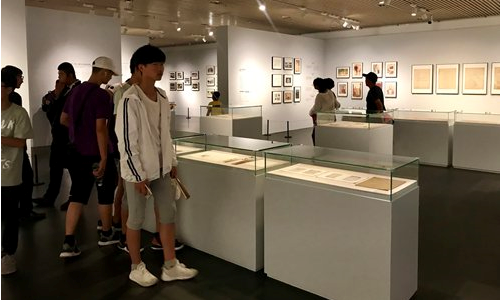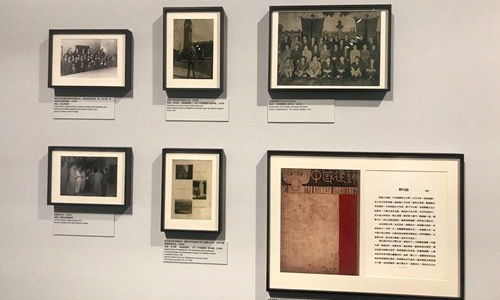HOME >> ARTS
Building a legacy
By Bi Mengying Source:Global Times Published: 2019/8/25 17:08:40
Exhibit introduces first generation of Chinese architects to study in US

Visitors explore the Accomplishment exhibition at the Tsinghua University Art Museum in Beijing on July 23. Photo: Bi Mengying/GT

Photographs on exhibition Photo: Bi Mengying/GT
Outside the Tsinghua University Art Museum in Beijing, elementary school students guided by their teachers waited patiently in line despite the scorching morning sun. There were also groups of tourists and jolly families hopping off buses. The museum for one of the top universities in China has been welcoming visitors across the country since it opened to the public in September 2016. They poured in and then went separate ways to different exhibition halls.On the second floor, was the exhibition Accomplishment - the First Generation of Chinese Architects Graduated from the University of Pennsylvania (UPenn). Intrigued visitors were walking around examining the photos and drawings on the walls. Right close by the entrance, which was jam-packed with visitors, there were several photos displaying the editorial from the inaugural issue of The Chinese Architect in 1931. The first academic journal in Chinese architecture history, it was published by an academic association primarily composed of Chinese architects in Shanghai, who were also some of the earliest overseas returnees.
One visitor was reading the editorial out loud, "combing the strength of Western and Eastern architecture to further highlight the existing colors of our country's architecture."
The pioneers
Friday marked the beginning of the exhibition's fifth week on display. Co-organized by the Tsinghua University Art Museum and the School of Architecture at Tsinghua University, the exhibition is scheduled to end on October 13.
According to the exhibition, in the early 20th century some 50 young students from China departed for the US to study architecture. At the time, the university boasted one of the largest contingents of Chinese students.
The exhibition explores the experiences of more than 20 Chinese overseas students who studied at the university from 1918 to 1935, while commemorating their pioneering academic achievements. It also aimed to reveal the profound impact the US education regarding theory of architecture left on Chinese academia.
The exhibition includes group photos of the Chinese architecture students that studied at UPenn, photos of them studying in classrooms and taking on tasks such as sketching, making models and drawing designs. These photos also revealed their colorful campus life such as showing them playing sports or dressed in fancy costumes at pageants or balls. There are also displays outlining their accomplishments and contributions to Chinese modern architecture after their return home.
Overcoming challenges
One of the 20 students would go on to become an iconic figure in the history of Chinese architecture, Liang Sicheng. Known as Father of Chinese Modern Architecture, Liang authored the first-of-a-king work A History of Chinese Architecture, the first of the kind. After returning to China, he founded architecture departments at Northeastern University in Northeast China's Liaoning Province in 1928 and Tsinghua University in 1946. He discovered the first and second oldest existent timber structures in China, along with scholars who also studied with him at UPenn including Mo Zongjiang, Ji Yutang and Lin Huiyin, who was also Liang's first wife.
While Lin was deemed as an important Chinese architect, she wasn't able to study architecture at UPenn.
"Because there was prejudice against women," explained Frederick Steiner, the dean of the school of design at UPenn, while he was visiting an exhibition about Liang and Lin held in Shanghai earlier this month.
"But she was able to study fine arts, and both fine arts and architecture are part of design. But she was so talented that, from my understanding, she taught drawing to the architecture students. So on one hand, she couldn't pursue architecture, but because of her talent, she was still able to teach many of the architecture students," he continued.
Steiner also pointed out that the first generation of Chinese architects studied at UPenn was important for China.
"Because it was a generation, a community of Chinese students who returned to China and became extremely influential here. For us, I think it's a reminder of the deep relationship between China and the United States in higher education, that our relationship with China at the University of Pennsylvania is not new. It goes back over 100 years," he noted.
As the tourists explored the exhibit, it seemed that many middle school and high school students were completely enthralled by the exhibition. Some were jotting down notes on their small notepads and others were surrounding the models on display, whispering to each in amazement.
"I love painting, and I like drawing architecture, especially Chinese architecture like those at Dunhuang… I want to study abroad before my sophomore year in college, especially in Germany," Fan Yaowen, a young man who had been taking a close look at each display.
An art student from the Xinjiang Uyghur Autonomous Region, he was in his second year of high school.
"I will consider the US as well…We have much to learn from that country as well," he added.